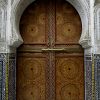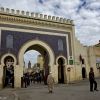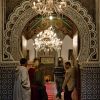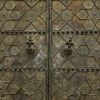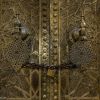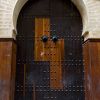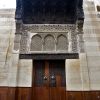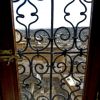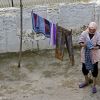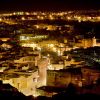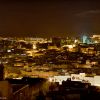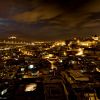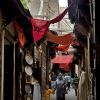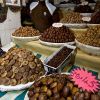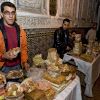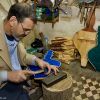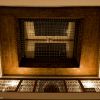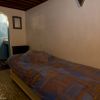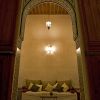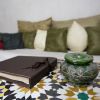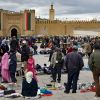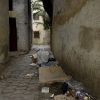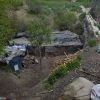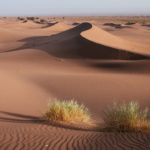The spiritual Dignity of Fes
The old hub of the Kingdom of Fès accommodates the biggest historical medina of Northern Africa, while also being home of at least a million people and spiritual centre of the country.
From time immemorial handcraft and trading plays a big, if not to say the biggest role in Fes; dexterities like pottery, tannery or dyeworks are still the actual basement of Fès’ Business. Who doesn’t know the city’s most known picture, published in worldwide known glossies: the idyllic image of tanners working next to their huge tiled clay tubs, while walking around bare feet all the time juggling their fabrics from one colour pot to another.
After all, in a country of 20% unemployment, tourism became an important field and is today a very important source of income. At the latest on arrival, whether by bus or train, you’ll see dozens of potential volunteers sieging travellers to work for them; baggage porters here, shoeshine man there and the friendly man who wants to show you the city isn’t far anymore as well. Though, disburdening one’s back until the Petit Taxi is in sight costs only some Dirhams and is a welcome gesture for both, Moroccans and your back. Fès itself is surprisingly big; from the train station to the central spot of the Old Town you can easily walk 4 or 5 kilometres. The CTM bus terminal is even more far away than the train station. Therefore the most commonly used transportation are the Petit Taxis, which costs about 15 Dirham per head for a such 4-5km ride; depending on traffic of course.
All roads lead to Rome. In case of Fès “Rome” literally stands for the blue embellished gate Bab Bou Jeloud, the medina’s linchpin and most frequented area. Not far from that place I expected my hotel Pension Batha. Unfortunately they carelessly lost my reservation. Usually that’s not a big problem, actually. But on an Easter weekend seeing half of Spain and two third of France invading Morocco, plus to boot the Moroccans having a long weekend due to the prophet’s birthday… Well, hotels were understandably few and far between; 35 requests, no free room. On top of it all that happened late, short before midnight. Having no place to stay overnight in sight is not really a positive feeling. Not at all.
Fortunately I met Youssef, who is taking care about a riad guesthouse owned by a French couple. Three girls from Spain encountered the same hotel reservation fate and thus we quickly found ourselves heading to Place R’Cif. That noticeable less touristy square was the origin for the way to the riad, which was something like: three times turning left, then straight to finish some never ending stairway, then turning left again and finally knocking on a door or getting your keys ready.
From outside often looking odd and non-appealing, from inside a true pearl; cosy, charming and authentic. That is one of the basic rules when visiting Arabian countries: never judge at first glance. The owners, Laurence and her husband Didier, spent almost two years on reconstructing their dream, a riad in the medina. All efforts resulted in a beautifully restored Arabic guesthouse, whose interior has a delightful cedar wood smell, while its three cosy rooms provide space for five people. The actual highlight is the lovely terrace though. In the face of a fantastic panorama, shining sun, nice-smelling crêpes, fresh-squeezed orange juice and excellent confiture even the biggest and most consequent breakfast grouch in the world will become weak and tuck in.
In contrast to Marrakech Fès is significantly quieter and fewer hectic. Here, in the Fès medina, you can have a quiet walk through the souq lanes; you won’t find yourself being attacked by honking all the time and pushy motorbikes. Though, locals pay attention to withhold non-Muslims (in fact tourists) from having a closer look at the mosques. On the one hand that is understandable, since those houses of the Lord are more frequently used, five times a day, and not only once a week like in Europe… Also the appearance/clothing of lots of tourists doesn’t fit, doesn’t even fit Christian norms. On the other hand keeping mosques totally away from visitors doesn’t support the dialogue between the religions. Western churches are very often accessible when being visited off the service hours. After my very positive experiences in Syria & Co. I was quite disappointed that in that case Morocco is only seeing black and white, no grey.
Another disenchantment was Morocco’s tidiness in general. It’s surely wrong to expect clinic sanitariness when walking through the lanes of one of the world’s oldest medinas. Though it’s pretty disgusting when sewage is emptied out on the roads so that together with donkey dung and compost it becomes to be an olfactorily unforgettable liaison for you. Also the rotting donkey (horse???) in the main road’s gutter channel doesn’t really testify piety towards cleanliness.
Photographically seen the light these days was too moderate. To boot Laurence expected guests coming from France and the hotel situation didn’t really change much. Only two days, that was too few to explore Fès, I’ll definitely return, but in my case I had to move and it took me to Marrakech as well as to the Moroccan desert to explore the Sahara a bit…
